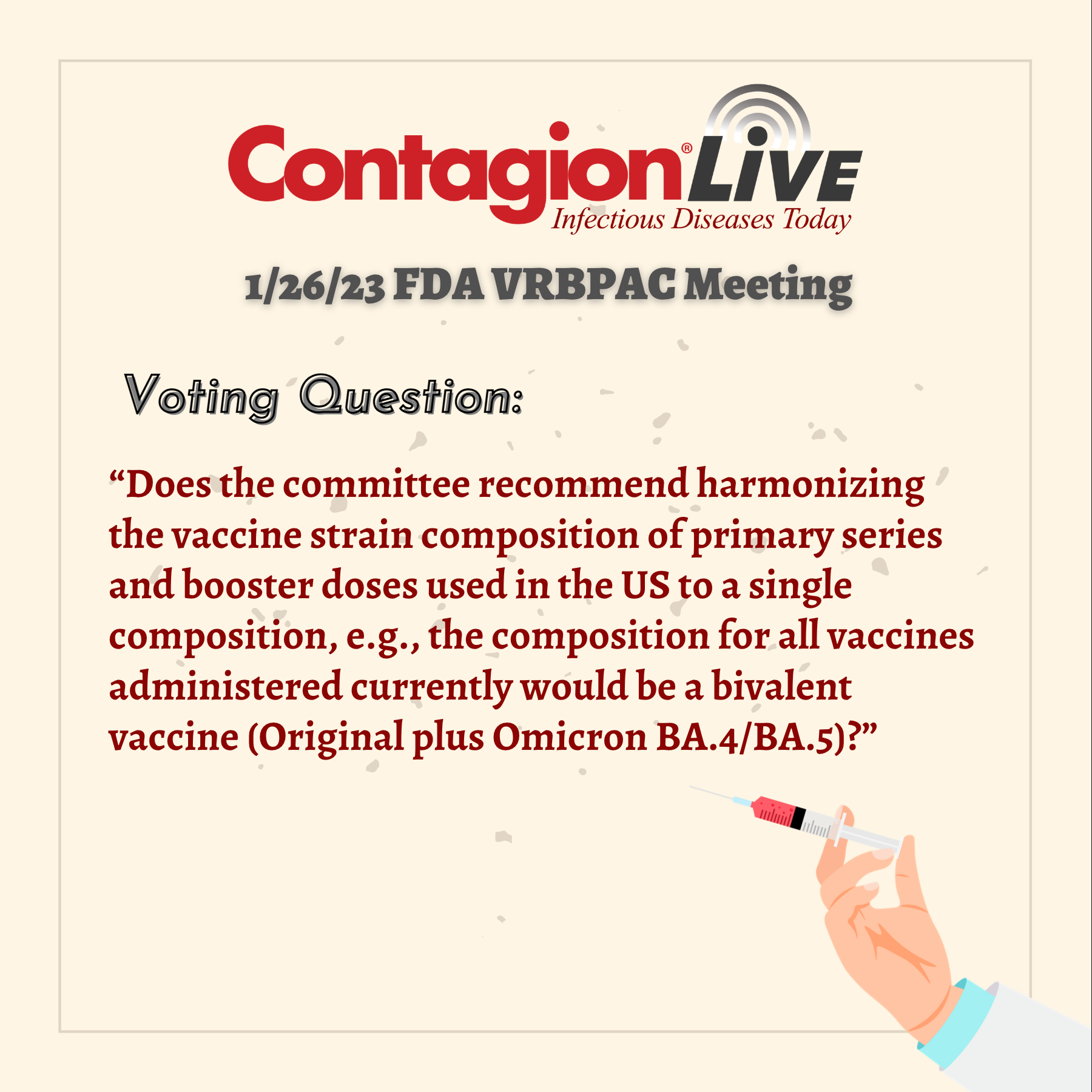FDA Advisory Committee Votes to Unify the Strain Composition of COVID-19 Primary and Booster Vaccines
The FDA’s Vaccines and Related Biological Products Advisory Committee (VRBPAC) voted to move toward a unified strain composition for COVID-19 primary and booster vaccines.

This story will be updated as VRBPAC continues to discuss immunization schedules and updated strain concentrations after the vote.
After a daylong meeting, the US Food and Drug Administration (FDA) Vaccines and Related Biological Products Advisory Committee (VRBPAC) voted to move toward a “harmonized” strain composition for COVID-19 primary and booster vaccines.
The virus continues to mutate rapidly, and after the success of the updated bivalent COVID-19 vaccine booster, VRBPAC was asked to establish a process for vaccine strain recommendations.
“This is a consequential meeting to determine if we’ve reached a point in the pandemic that allows for simplifying the use of COVID-19 vaccines,” said David C. Kaslow, MD, director of the FDA’s Office of Vaccines Research and Review, at the beginning of the today’s session.
At 4:36 pm, committee officials announced VRBPAC voted “YES” 21-0 on the following question:
“Does the committee recommend harmonizing the vaccine strain composition of primary series and booster doses in the US to a single composition, e.g., the composition for all vaccines administered currently would be a bivalent vaccine (Original plus Omicron BA.4/BA.5)?”
Before the vote and subsequent discussions, VRBPAC was presented with data from CDC, FDA, and National Institutes of Health (NIH) experts, as well as from preeminent COVID-19 vaccine developers Moderna, Pfizer-BioNTech, and Novavax.
Centers for Disease Control and Prevention (CDC) acting Surveillance and Analytics team lead Heather Scobie, PhD, MPH, noted that over 229.5 million people in the US received a primary COVID-19 vaccine series, and 50.6 million Americans have received an updated bivalent booster.
“Hospitalizations have consistently been higher in unvaccinated than vaccinated people over time,” Scobie said, presenting data showing adults who received a bivalent booster were 16 times less likely to be hospitalized with COVID-19 and 13 times less likely to die of COVID-19 than unvaccinated individuals. Bivalent boosted adults were also 3 times less likely to be hospitalized and 2 times less likely to die than adults who were vaccinated but had not received a bivalent booster.
The 2 approved bivalent COVID-19 boosters, Pfizer-BioNTech and Moderna, contain the ancestral wild-type COVID-19 strain and the Omicron BA.4/BA.5 sublineages.
After the unanimous decision, VRBPAC discussed 2 key topics:
Discussion Topic 1—Simplification of COVID-19 vaccine use:
Immunization schedule: Please discuss and provide input on simplifying the immunization schedule to authorize or approve a 2-dose series in certain young children, and in older adults and persons with compromised immunity, and only 1 dose in all other individuals.
Discussion Topic 2—Periodic update to COVID-19 vaccines:
Vaccine composition: Please discuss and provide input on the consideration of periodic updates to COVID-19 vaccine composition, including to the currently authorized or approved vaccines available for use in the US in the fall of 2023.
“There is a public health need for next-generation vaccines,” said NIH presenter John Beigel, MD, associate director for clinical research in the Division of Microbiology and Infectious Diseases.
Beigel argued that next-generation vaccines will provide broader protection and increased durability against emerging variants. However, we still need to better understand the immune responses that enable protection against infection and transmission.
There was a lengthy discussion regarding a vaccination schedule for young children. One committee member noted that although there are antivirals available for severe COVID-19 infections, these therapies are often not approved for use in children, heightening the need to solidify a safe and effective COVID-19 regimen for children.
“The preponderance of the data from vaccine manufacturers and independent researchers indicate an improved antibody response to SARS-CoV-2 Omicron variants following mRNA booster vaccination with the recommended bivalent vaccine containing an Omicron BA.4/BA.5 component,” said Jerry Weir, PhD, director of the FDA Division of Viral Products, in his presentation.
Though current primary COVID-19 vaccine series remain monovalent, Weir advocated for bivalent COVID-19 vaccines as the way forward, suggesting “Consideration of the same vaccine strain composition for primary and booster vaccinations.”
VRBPAC members and presenters frequently used the influenza vaccine as an analogy for the need to update the COVID-19 vaccine strain composition. One of this meeting’s objectives was to convene a strain selection meeting as needed between routine periodic strain selection, in order to address a more pathogenic escape variant.
“A move to a single vaccine strain composition for primary and booster vaccination in the US would align with a recent recommendation from the European Medicines Agency Emergency Task Force,” Weir noted.
